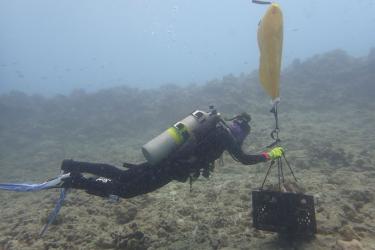Scientists from NOAA’s Pacific Islands Fisheries Science Center are using autonomous surface vehicles called Wave Gliders to study ocean health in Hawaiʻi. Wave Gliders are circumnavigating each of the Hawaiian Islands. They’re collecting data on ocean conditions that will be used to help estimate the impacts of climate change on marine ecosystems and fisheries across the state.
“We are primarily interested in measuring chlorophyll, which provides a good estimate of phytoplankton biomass in the ocean,” said Dr. Jamison Gove, an oceanographer with the Pacific Islands Fisheries Science Center and co-lead scientist on the project. “Phytoplankton are the basis for productive and healthy ecosystems, so knowing where and how much phytoplankton there are in the ocean aids in understanding the entire marine food-web,” added Dr. Gove.
The Building Blocks of Ocean Ecosystems
Phytoplankton are microscopic plants that live near the ocean surface. They are similar to land-based plants: They contain chlorophyll and require sunlight to live and grow. Phytoplankton are the base of the food chain. Their biomass—the total amount of them in a given region of the ocean—dictates fisheries yields and ecosystem productivity across the world.
“Most ocean regions in the tropics have relatively low levels of phytoplankton biomass, but they typically increase as you get closer to islands, like Hawaiʻi,” said Dr. Jonathan Whitney, research ecologist with the Pacific Islands Fisheries Science Center and co-lead of the project. “These phytoplankton hotspots near islands are especially critical for supporting island ecosystems, as they provide more food for small fish and ultimately top predators such as tunas, sharks, and whales.” Scientists are studying phytoplankton distributions and gathering information on key ocean conditions such as temperature, oxygen, and salinity. This information helps them understand the underlying drivers of ecosystem health and estimate how climate change will impact local ecosystems in the coming decades.
“Climate change is increasing ocean temperatures and impacting the distribution and production of phytoplankton,” said Dr. Gove. “But how large-scale changes will influence marine ecosystems here in Hawaiʻi is not well understood. This uncertainty is challenging for resource management and for local communities, especially where fisheries provide important food-resources and support economic livelihoods.”
Powered by the Waves
Our scientists have contracted Liquid Robotics to use Wave Gliders, autonomous surface vehicles that harness the upward and downward motion of ocean waves. The wave-powered vehicles are continuously propelled forward while taking measurements on ocean conditions. For this study, three Wave Gliders will be traveling in tandem at 1.5, 3, and 6 kilometers from shore. They will measure temperature, salinity, phytoplankton, and more to a depth of 150 meters. The Wave Gliders will begin their mission on Hawai'i Island and then head northwest, circumnavigating each of the Main Hawaiian Islands. The journey will take 5–6 weeks to complete. Then, researchers will analyze the data to identify the locations with the greatest phytoplankton biomass. They will determine the drivers of these biological hotspots and their contribution to ocean ecosystem function and health.
A Collaborative Effort
The statewide ocean survey is part of the Hawaiʻi Integrated Ecosystem Assessment. It will be coupled with NOAA’s ongoing monitoring of whales and dolphins during the Hawaiian Islands Cetacean and Ecosystem Assessment Survey.
“The autonomous Wave Glider survey is supporting a larger, multi-agency collaborative effort to assess the abundance and habitat of whales and dolphins across Hawai‘i,” said Dr. Erin Oleson, marine ecologist at the Pacific Islands Fisheries Science Center and lead scientist of the survey. This effort occurs just once every 6–8 years and assesses the status and trends in cetacean populations in Hawaiʻi. “The Wave Gliders will provide really important data on ocean conditions and habitat near each of the islands, which are utilized by numerous species of whales and dolphins.”
This project is in collaboration with researchers from the University of Hawaiʻi at Mānoa Department of Oceanography and supported by NOAA’s Uncrewed Systems Operations Center, which funded innovative partnerships in an effort to collect data for NOAA missions.





